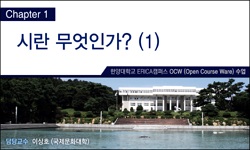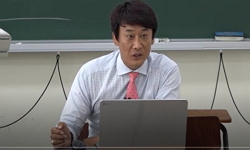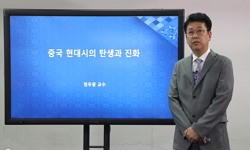This study is a cognitive poetics. Through this study, I'll search elements that mediate between a poet's creative process and a reader's application. I will also theorize which principles and procedures are needed to incorporate the text underlying i...
http://chineseinput.net/에서 pinyin(병음)방식으로 중국어를 변환할 수 있습니다.
변환된 중국어를 복사하여 사용하시면 됩니다.
- 中文 을 입력하시려면 zhongwen을 입력하시고 space를누르시면됩니다.
- 北京 을 입력하시려면 beijing을 입력하시고 space를 누르시면 됩니다.
https://www.riss.kr/link?id=T10065926
- 저자
-
발행사항
제주 : 濟州大學校 大學院, 2003
- 학위논문사항
-
발행연도
2003
-
작성언어
한국어
- 주제어
-
KDC
811 판사항(4)
-
발행국(도시)
제주특별자치도
-
형태사항
ii, 190p. : 삽도 ; 26cm.
-
일반주기명
참고문헌: p. 177-186
- 소장기관
-
0
상세조회 -
0
다운로드
부가정보
다국어 초록 (Multilingual Abstract)
This study is a cognitive poetics. Through this study, I'll search elements that mediate between a poet's creative process and a reader's application. I will also theorize which principles and procedures are needed to incorporate the text underlying in the grammatical system into the work of poetic system.
This study makes it clear that thought and emotion are the important principles of realizing poetic meaning and that the interaction of these two principles solidifies the various aspects of meaning.
The process of creating a poem is considered as the thinking process of <meaning>→<phonemic structure→lexical structure→syntactic structure>→<text> that is applied to individual words, and the emotional process of <stimulus>→<phonemic structure→lexical structure→syntactic structure>→<text>.
If emotion is enforced, a poet may transcend the social and stereotyped frames. By reflecting new personal and individual phonemes, lexical items, or syntax into a text, a poet may make a thought statement which destroys routine grammar rules. With this, a thought will belong to an emotion, and a text will shape a structure of <emotional phoneme(thinking)↔emotional lexical items(thinking)↔emotional syntax(thinking)>. Therefore, the text is manifested in the structure of deviating from or destroying normal grammar because it is an arrangement of signs. However, if we find a subconscious thought that belongs to an emotion, we could confirm a normal grammar structure and apprehend the meaning of an emotion.
Accordingly, the types of texts are divided by the interfusing intention between a poet's thought and emotion and the dimensions of movement. Also by the effect of emotion the relationship of sign and meaning is changed from the lexical meaning through the encyclopedic meaning to the poetic meaning. Consequently it can be divided into the notion-oriented poem that regards a poetic notion as a meaning, the image-oriented poem that regards a poetic image as a meaning and the sign-oriented poem that considers a poetic sign as a meaning.
The process of a reader's objective application of thought and emotion embedded in a poem is manifested in three procedures such as <searching for meaning>, <certifying an interrelation>, and <establishing a contextual sense>. Resulting from these, a reader's creative application would be shaped by a imagination liberated by the destruction of the relationship of sign and meaning, an emotional response that helps people grasp soundly textual information and the cohesion of imaginary scenes and experience structures.
In the field of poetry, there is a different language convention: a poetic grammar with a language convention that an emotion is superior or equal to a thought. This characteristic manifests as the destruction and extension of routine grammar, according to the direction of emotion and the strength and weakness of it.
Therefore, poetry teaching needs the mutually connected and complementary relationship of the following three elements: a teacher instructing a poetic grammar as a principle, a student who learns it and appreciates it and the creative extraction of a principle from the text. Based on these, the real process of teaching and appreciating poetry is constructed.
목차 (Table of Contents)
- 목차
- I. 서론 = 1
- 1. 연구의 목적 = 1
- 2. 연구사의 검토 = 3
- 3. 연구 방법 = 12
- 목차
- I. 서론 = 1
- 1. 연구의 목적 = 1
- 2. 연구사의 검토 = 3
- 3. 연구 방법 = 12
- II. 시 텍스트의 창작과정
- 1. 시 텍스트에서의 사고와 정서 = 18
- 1) 사고와 정서의 작용 = 19
- 2) 사고와 정서의 조직 절차 = 28
- 3) 사고와 정서의 유형에 따른 시 텍스트 유형 = 37
- 2. 시 텍스트의 의미화 과정 = 52
- 1) 시적 개념 체계로 변환 = 57
- 2) 시적 이미지 체계로 변환 = 64
- 3) 시적 기표 체계로 변환 = 64
- III. 시 텍스트의 수용과정 = 75
- 1. 텍스트에 따른 객관적 수용 = 75
- 1) 기의 검색 = 77
- 2) 계열성의 확인 = 82
- 3) 의미 확정 = 85
- 2. 재창조 과정 = 92
- 1) 기표와 기의 관계 파괴를 통한 자유연상 = 92
- 2) 정서 반응을 통한 깨달음 = 97
- 3) 가상과 경험의 결합을 통한 재창조 = 101
- IV. 시 텍스트의 교육원리 = 106
- 1. 시 텍스트의 특수성 = 106
- 1) 시문법과 일반문법의 관계 = 108
- 2) 시 텍스트의 문법 구조 = 117
- 3) 시문법의 교육 원리 = 134
- 2. 시 텍스트 지도 방안의 실제 = 146
- V. 결론 = 165
- 참고 문헌 = 177
- 〈abstract〉 = 187












